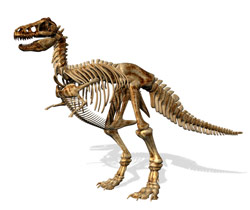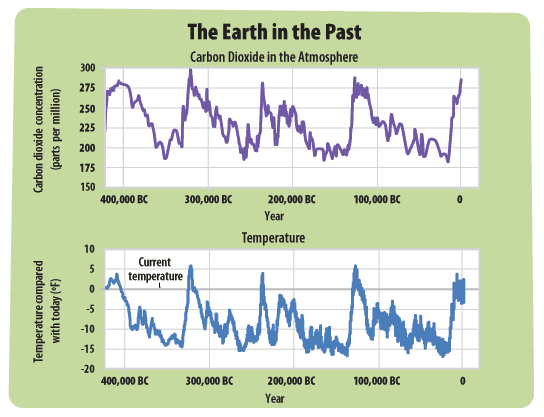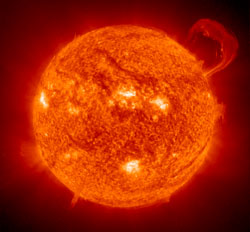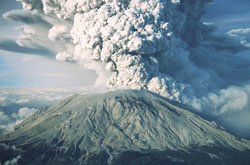What Can We Learn About Past Climate Changes From Ice Cores
The Earth's Climate in the Past

The Earth was formed about 4.5 billion years ago—that'southward a very long time ago! It'due south hard to say exactly what the Earth's daily weather was like in whatsoever particular place on whatever item twenty-four hour period thousands or millions of years ago. Only we know a lot about what the Earth'due south climate was like fashion back then considering of clues that remain in rocks, ice, trees, corals, and fossils.
These clues tell u.s. that the Earth'due south climate has changed many times before. There accept been times when about of the planet was covered in ice, and there have also been much warmer periods. Over at least the last 650,000 years, temperatures and carbon dioxide levels in the atmosphere have increased and decreased in a cyclical pattern. Can you come across this design in the graph below?

These graphs are based on the Vostok ice core from Antarctica. They do not include the virtually recent increases in carbon dioxide and temperature caused by humans. Notice the potent connection between carbon dioxide and temperature. Source: EPA's Climatic change Indicators (2016) and Petit et al. (2001).
People didn't cause the climatic change that occurred thousands or millions of years ago, so information technology must have happened for other natural reasons.
Explore the list below to learn about some natural factors that take changed the Earth's climate in the past.
Changes in the Earth'due south orbit

The shape of the Earth's orbit effectually the sun naturally changes over time, and and so does the fashion the World tilts toward the sun. Many of these changes happen in cycles that repeat over tens of thousands of years. These changes touch how much of the lord's day'due south energy the World absorbs, which in turn affects the Earth'due south temperature. Over at least the last few 1000000 years, these cycles likely caused the Earth to alternate betwixt cold and warm periods. For the final few 1000 years, we've been in a relatively warmer menstruation.
About 20,000 years ago, ice sheets covered large parts of North America, where they extended as far southward as where Chicago is now. In some places, this ice was a mile deep!
Source: Adapted from NASA (2011).
Changes in the sun's energy

The sun goes through sunspot cycles every eleven years or then. During times when there are sunspots, nighttime spots—some as big as 50,000 miles wide—motion beyond the surface of the sun. When this happens, the lord's day gives off slightly more energy, which makes the Earth a bit warmer. The dominicus also goes through longer term changes that affect how much free energy information technology gives off.
Photosynthesis

The Earth'due south start billion years were very different from the conditions today. The sunday was cooler and so, simply the planet was by and large warmer. That's because there were a lot of greenhouse gases, like carbon dioxide and methane, in the atmosphere. Also, the atmosphere back so contained very little oxygen. It was a very different earth—a earth without people or the kinds of plants and animals that thrive in today'due south climate. But photosynthesis, which became mutual nearly 2 billion years ago, inverse all that. During photosynthesis, plants take carbon dioxide out of the temper and replace it with oxygen. Photosynthesis permanently changed the atmosphere by adding more oxygen to the air while reducing the amount of greenhouse gases.
Volcanic eruptions

When volcanoes erupt, they spew more than red hot lava! They too add carbon dioxide to the atmosphere, forth with dust, ash, and other particles called aerosols. At certain times during the history of the World, some very active volcanoes added a lot of carbon dioxide to the atmosphere, causing the planet to get warmer. However, virtually of the time, including today, the major effect from volcanoes is actually cooling the Earth considering aerosols block some sunlight from reaching us. If an eruption is big enough to launch these particles high into the temper, it can atomic number 82 to slightly cooler temperatures around the globe for a few years.
Scientists around the world hold that today's global climate change is mainly caused by people's activities.
Top of page
« Previous
Source: https://archive.epa.gov/climatechange/kids/basics/past.html
Posted by: thorntonhishad.blogspot.com

0 Response to "What Can We Learn About Past Climate Changes From Ice Cores"
Post a Comment